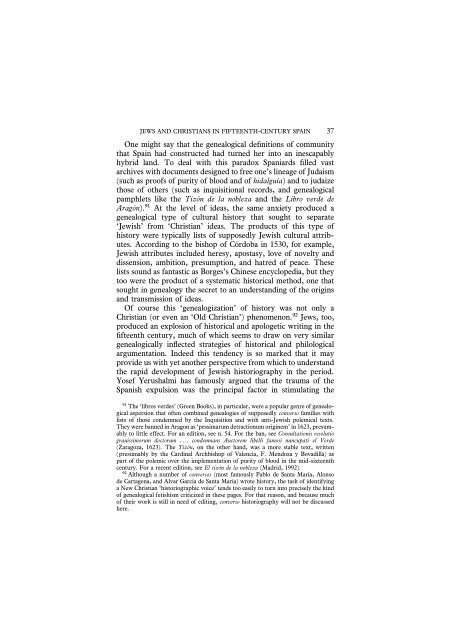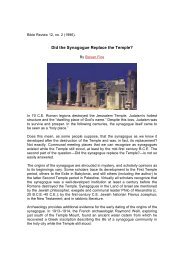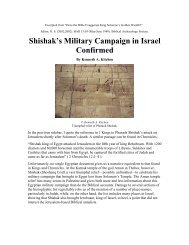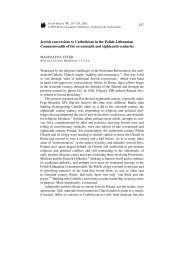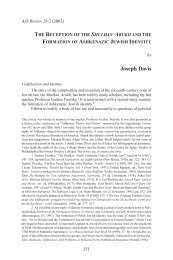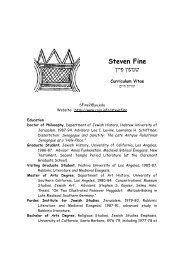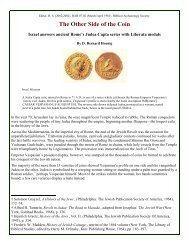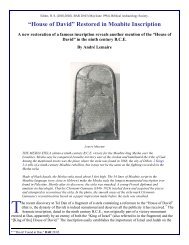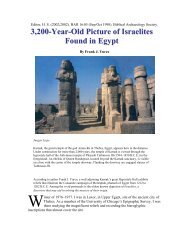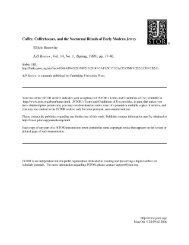jews and christians in fifteenth-century spain
jews and christians in fifteenth-century spain
jews and christians in fifteenth-century spain
Create successful ePaper yourself
Turn your PDF publications into a flip-book with our unique Google optimized e-Paper software.
JEWS AND CHRISTIANS IN FIFTEENTH-CENTURY SPAIN<br />
One might say that the genealogical def<strong>in</strong>itions of community<br />
that Spa<strong>in</strong> had constructed had turned her <strong>in</strong>to an <strong>in</strong>escapably<br />
hybrid l<strong>and</strong>. To deal with this paradox Spaniards filled vast<br />
archives with documents designed to free one’s l<strong>in</strong>eage of Judaism<br />
(such as proofs of purity of blood <strong>and</strong> of hidalguía) <strong>and</strong> to judaize<br />
those of others (such as <strong>in</strong>quisitional records, <strong>and</strong> genealogical<br />
pamphlets like the Tizón de la nobleza <strong>and</strong> the Libro verde de<br />
Aragón).91 At the level of ideas, the same anxiety produced a<br />
genealogical type of cultural history that sought to separate<br />
‘Jewish’ from ‘Christian’ ideas. The products of this type of<br />
history were typically lists of supposedly Jewish cultural attributes.<br />
Accord<strong>in</strong>g to the bishop of Córdoba <strong>in</strong> 1530, for example,<br />
Jewish attributes <strong>in</strong>cluded heresy, apostasy, love of novelty <strong>and</strong><br />
dissension, ambition, presumption, <strong>and</strong> hatred of peace. These<br />
lists sound as fantastic as Borges’s Ch<strong>in</strong>ese encyclopedia, but they<br />
too were the product of a systematic historical method, one that<br />
sought <strong>in</strong> genealogy the secret to an underst<strong>and</strong><strong>in</strong>g of the orig<strong>in</strong>s<br />
<strong>and</strong> transmission of ideas.<br />
Of course this ‘genealogization’ of history was not only a<br />
Christian (or even an ‘Old Christian’) phenomenon.92 Jews, too,<br />
produced an explosion of historical <strong>and</strong> apologetic writ<strong>in</strong>g <strong>in</strong> the<br />
<strong>fifteenth</strong> <strong>century</strong>, much of which seems to draw on very similar<br />
genealogically <strong>in</strong>flected strategies of historical <strong>and</strong> philological<br />
argumentation. Indeed this tendency is so marked that it may<br />
provide us with yet another perspective from which to underst<strong>and</strong><br />
the rapid development of Jewish historiography <strong>in</strong> the period.<br />
Yosef Yerushalmi has famously argued that the trauma of the<br />
Spanish expulsion was the pr<strong>in</strong>cipal factor <strong>in</strong> stimulat<strong>in</strong>g the<br />
91 The ‘libros verdes’ (Green Books), <strong>in</strong> particular, were a popular genre of genealogical<br />
aspersion that often comb<strong>in</strong>ed genealogies of supposedly converso families with<br />
lists of those condemned by the Inquisition <strong>and</strong> with anti-Jewish polemical texts.<br />
They were banned <strong>in</strong> Aragon as ‘pessimarum detractionum orig<strong>in</strong>em’ <strong>in</strong> 1623, presumably<br />
to little effect. For an edition, see n. 54. For the ban, see Consultationis resolutio<br />
grauissimorum doctorum . . . condemnans Auctorem libelli famosi nuncupati el Verde<br />
(Zaragoza, 1623). The Tizón, on the other h<strong>and</strong>, was a more stable text, written<br />
(presumably by the Card<strong>in</strong>al Archbishop of Valencia, F. Mendoza y Bovadilla) as<br />
part of the polemic over the implementation of purity of blood <strong>in</strong> the mid-sixteenth<br />
<strong>century</strong>. For a recent edition, see El tizón de la nobleza (Madrid, 1992).<br />
92 Although a number of conversos (most famously Pablo de Santa María, Alonso<br />
de Cartagena, <strong>and</strong> Alvar García de Santa María) wrote history, the task of identify<strong>in</strong>g<br />
a New Christian ‘historiographic voice’ tends too easily to turn <strong>in</strong>to precisely the k<strong>in</strong>d<br />
of genealogical fetishism criticized <strong>in</strong> these pages. For that reason, <strong>and</strong> because much<br />
of their work is still <strong>in</strong> need of edit<strong>in</strong>g, converso historiography will not be discussed<br />
here.<br />
37


